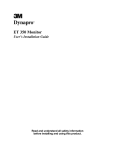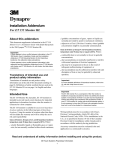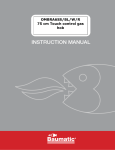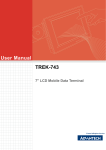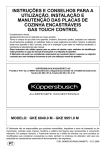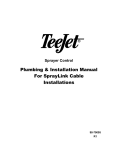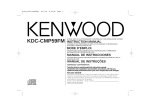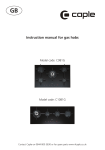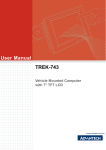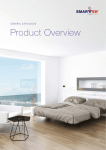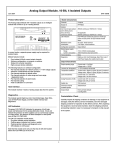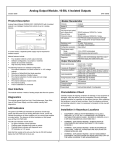Download TSC1 Technical Manual
Transcript
TSC1 Analog Resistive Touchscreen Controller Technical Manual TSC1 Technical Manual Definitions Arcom is the trading name for Arcom Control Systems Inc and Arcom Control Systems Ltd. Disclaimer The information in this manual has been carefully checked and is believed to be accurate. Arcom assumes no responsibility for any infringements of patents or other rights of third parties, which may result from its use. Arcom assumes no responsibility for any inaccuracies that may be contained in this document. Arcom makes no commitment to update or keep current the information contained in this manual. Arcom reserves the right to make improvements to this document and/or product at any time and without notice. Warranty This product is supplied with a full 3 year warranty. Product warranty covers failure caused by any manufacturing defects. Arcom will make all reasonable effort to repair the product or replace it with an identical variant. Arcom reserves the right to replace the returned product with an alternative variant or an equivalent fit, form and functional product. Delivery charges will apply to all returned products. Please go to www.arcom.com/support for information about product return forms. Trademarks Windows 98, Windows NT, Windows 2000 and Windows XP are trademarks or registered trademarks of the Microsoft Corporation. DuboxTM is a trademark of Framatome Connectors International. 3MTM and DynaproTM are trademarks of 3M Limited. All other trademarks recognized. Revision history Manual PCB Date Comments Issue A V1I1 8th Nov 2001 First release of manual. Issue B Issue C Issue D Issue E V1I2 V1I2 mod A V1I2 mod A V1I2 mod C th Connector pinouts changed on V1 Iss2 boards. th 10-bit Operation option added rd Jumper setting correction for 5-wire interface 11 July 2002 24 June 2003 23 July 2003 th 9 May 2005 © 2006 Arcom. Arcom is a subsidiary of Eurotech Group. www.eurotech.com For contact details, see page 28. Arcom operates a company-wide quality management system which has been certified by the British Standards Institution (BSI) as compliant with ISO9001:2000 Jumper LK4 operation added TSC1 Technical Manual Contents Contents Introduction ........................................................................................................................................4 Handling your board safely ....................................................................................................4 TSC1 touchscreen controller ‘at a glance’ .............................................................................5 Features of the TSC1.............................................................................................................6 About this manual ..............................................................................................................................7 Conventions ...........................................................................................................................7 Jumpers and connectors....................................................................................................................8 Jumpers .................................................................................................................................9 Connectors...........................................................................................................................16 PL3 - Serial port ...................................................................................................................16 PL1 - Alternative serial port..................................................................................................17 PL5 - Power input ................................................................................................................17 PL2 - 8-wire touchscreen interface ......................................................................................18 PL4 - 5-wire touchscreen interface ......................................................................................18 PL6 - 4-wire touchscreen interface ......................................................................................19 Using the TSC1................................................................................................................................20 Serial interface port..............................................................................................................20 Touchscreen interface..........................................................................................................20 Modes of operation ..............................................................................................................21 LEDs ....................................................................................................................................22 Software drivers ...................................................................................................................23 Temperature issues..............................................................................................................25 Interference due to RF emissions ........................................................................................26 Power supply ...................................................................................................................................27 Power input ..........................................................................................................................27 Appendix A – Contacting Arcom.......................................................................................................28 Appendix B – Compatible touchscreens ..........................................................................................29 Appendix C – Dimensional information............................................................................................30 Appendix D – Reference information ...............................................................................................31 Appendix E – Acronyms and abbreviations .....................................................................................32 Index ................................................................................................................................................33 © 2005 Arcom Issue E 3 TSC1 Technical Manual Introduction Introduction The TSC1 is an analog resistive touchscreen controller board. It serves as an interface between 4, 5 or 8-wire resistive touchscreens and an Arcom single board computer via one of its serial ports. For information about ordering boards, please contact a member of the Arcom sales team. See Appendix A – Contacting Arcom, page 28. Handling your board safely Anti-static handling This board contains CMOS devices that could be damaged in the event of static electricity being discharged through them. At all times, please observe anti-static precautions when handling the board. Always unpack and install it in an anti-static working area. Packaging Should a board need to be returned to Arcom, please ensure that it is adequately packed, preferably in the original packing material. Use an anti-static bag for the board and use a box (rather than a bag) to physically protect the board. An anti-static bag is not required if the board is being returned in the original Development Kit box, which has an anti-static foam interior. Damage caused in transit may invalidate a warranty claim. Electromagnetic compatibility (EMC) The TSC1 is classified as a component with regard to the European Community EMC regulations. It is the user’s responsibility to ensure that systems using the board are compliant with the appropriate EMC standards. Arcom EMC tests of the TSC1 have shown that the RF emissions of the board are well below standard international EMC limits and that it is unlikely to contribute significantly to the RF emissions spectrum of any system in which it is used. © 2005 Arcom Issue E 4 TSC1 Technical Manual Introduction TSC1 touchscreen controller ‘at a glance’ Serial port Alternative serial port LEDs 8-wire touchscreen interface 5-wire touchscreen interface Power © 2005 Arcom Issue E IC4 microcontroller 4-wire touchscreen interface 5 TSC1 Technical Manual Introduction Features of the TSC1 The features included in the TSC1 are described below. Interfaces • Link selectable interface to 4, 5 or 8-wire resistive touchscreens. • RS232 interface to single board computer (4800 or 19200 baud). • Optional RS485 interface variant for long distance communication. (Contact the Arcom sales team for further details; see page 28). • 10-bit A/D (selectable 8-bit or 10-bit output to single board computer). Operation mode • Operates in continuous touch mode. • Power and valid-touch LEDs. • 5V DC power input. • Power consumption typically 35mA @ 5V DC. • 0°C to +60°C (32°F to 140°F) operating temperature range. • -20°C to +85°C (-4°F to 185°F) storage temperature range. • 743,000 hours; calculated using generic figures from MIL-HDBK-217F at ground benign. LEDs Power Temperature MTBF © 2005 Arcom Issue E 6 TSC1 Technical Manual About this manual About this manual This manual describes the operation and use of the TSC1. It is designed to be a reference and user manual and includes information about all aspects of the board. Conventions Symbols The following symbols are used in this guide: Symbol Explanation Note - information that requires your attention. Tip - a handy hint that may provide a useful alternative or save time. Caution – proceeding with a course of action may damage your equipment or result in loss of data. Jumper is fitted. Jumper is not fitted. © 2005 Arcom Issue E 7 TSC1 Technical Manual Jumpers and connectors Jumpers and connectors The following diagram shows the jumpers and connectors on the TSC1. Click on any jumper or connector name for more information. PL3 PL1 LK1 LK2 LK3 PL2 PL4 PL6 PL5 © 2005 Arcom Issue E LK6 LK5 LK4 LK7 LK11 LK10 LK9 LK8 8 TSC1 Technical Manual Jumpers and connectors Jumpers There are 11 user-selectable jumpers on the TSC1. They are summarised in the following table: Jumper Description See… LK1 Reserved. Do not fit. Page 9. LK2 10-bit output select. Page 9. LK3 Baud select. Page 10. LK4 8-wire panel option. Page 10. LK5 5-wire panel select. Page 11. LK6 Low voltage programming. Page 11. LK7 5-wire voltage reference input. Page 11. LK8 4-wire resistive touchscreen interface. Page 12. LK9 5-wire voltage reference input and 4-wire resistive touchscreen interface. Page 12. LK10 4-wire resistive touchscreen interface. Page 12. LK11 4-wire resistive touchscreen interface. Page 12. Reserved jumper - LK1 This jumper is unused. Do not fit. Default setting: 10-bit output select - LK2 This jumper can be used to enable 10-bit output from the TSC1. The host SBC must use compatible 10-bit driver software. LK2 Description Enable 10-bit output from TSC1. Default setting: TSC1 output is 8-bit only. © 2005 Arcom Issue E 9 TSC1 Technical Manual Jumpers and connectors Baud select - LK3 This jumper can be used to change the baud rate from 4800 to 19200. You should normally use 19200 when running in 10-bit mode and 4800 baud when running in 8-bit mode. LK3 Description 19200 baud. Default setting: 4800 baud. 8-wire panel option - LK4 Some large 8-wire panels may have valid touches at the extreme edges of the panel that are not detected as valid touches by the TSC1. You can fit this jumper to extend the range of valid inputs for 4 and 8-wire operation. This jumper is not fitted for normal operation. LK4 Description Range of valid inputs extended. Default setting: Standard input range. © 2005 Arcom Issue E 10 TSC1 Technical Manual Jumpers and connectors 5-wire panel select - LK5 This jumper must be fitted when interfacing to 5-wire resistive touchscreens. See also jumpers LK7 and LK9, below. LK5 Description When interfacing with 5-wire resistive touchscreens. Default setting: When interfacing with 4 or 8-wire resistive touchscreens. Low voltage programming - LK6 This jumper is for factory use only and is fitted when your TSC1 is supplied. Do not remove. Default setting: 5-wire voltage reference inputs - LK7, LK9 Fit these jumpers when interfacing to 5-wire resistive touchscreens. These jumpers are also fitted when interfacing to 4-wire touchscreens (see 4-wire interface jumper settings, below). LK7 Description When interfacing with 5-wire (and 4wire) resistive touchscreens. Default setting: When interfacing with 8-wire resistive touchscreens. LK9 Description When interfacing with 5-wire (and 4wire) resistive touchscreens. Default setting: When interfacing with 8-wire resistive touchscreens. © 2005 Arcom Issue E 11 TSC1 Technical Manual Jumpers and connectors 4-wire interface - LK8, LK9, LK10 and LK11 These jumpers are used when interfacing with 4- and 8-wire resistive touchscreens. They must be fitted when interfacing to 4-wire resistive touchscreens, and removed when using 8-wire touchscreens. LK8 Description Interface with 4-wire resistive touchscreen. Default setting: Interface with 8-wire resistive touchscreen. LK9 Description Interface with 4-wire resistive touchscreen. Default setting: Interface with 8-wire resistive touchscreen. LK10 Description Interface with 4-wire resistive touchscreen. Default setting: Interface with 8-wire resistive touchscreen. LK11 Description Interface with 4-wire resistive touchscreen. Default setting: Interface with 8-wire resistive touchscreen. © 2005 Arcom Issue E 12 TSC1 Technical Manual Jumpers and connectors Jumper settings The following diagrams illustrate the TSC1 jumper settings required for the interfaces and output modes you might use. 4-wire interface, 8-bit output mode (factory default) PWR TX PL1 D1 D2 RX D3 LK3 LK1 LK2 PL2 PL3 PL5 IC4 LK4 LK5 LK6 PL4 LK7 LK8 LK9 LK10 GND +5V PL6 LK11 4-wire interface, 10-bit output mode PWR TX PL1 D1 D2 RX LK3 D3 LK1 LK2 PL2 PL3 PL5 LK4 LK5 LK6 IC4 PL4 LK7 LK8 LK9 LK10 GND +5V PL6 LK11 © 2005 Arcom Issue E 13 TSC1 Technical Manual Jumpers and connectors 8-wire interface, 8-bit output mode PWR TX PL1 D1 D2 RX LK3 D3 LK1 LK2 PL2 PL3 PL5 IC4 LK4 LK5 LK6 PL4 LK7 LK8 LK9 LK10 GND +5V PL6 LK11 8-wire interface, 10-bit output mode PWR TX PL1 D1 D2 RX LK3 D3 LK1 LK2 PL2 PL3 PL5 LK4 LK5 LK6 IC4 PL4 LK7 LK8 LK9 LK10 GND +5V PL6 LK11 © 2005 Arcom Issue E 14 TSC1 Technical Manual Jumpers and connectors 5-wire interface, 8-bit output mode PWR TX PL1 D1 D2 RX LK3 D3 LK1 LK2 PL2 PL3 PL5 IC4 LK4 LK5 LK6 PL4 LK7 LK8 LK9 LK10 GND +5V PL6 LK11 5-wire interface, 10-bit output mode PWR TX PL1 D1 D2 RX LK3 D3 LK1 LK2 PL2 PL3 PL5 LK4 LK5 LK6 IC4 PL4 LK7 LK8 LK9 LK10 GND +5V PL6 LK11 © 2005 Arcom Issue E 15 TSC1 Technical Manual Jumpers and connectors Connectors There are 6 connectors on the TSC1. Connector Function See … PL3 Serial port. Page 16. PL1 Alternative serial port. Page 17. PL5 Power input. Page 17. PL2 8-wire touchscreen interface. Page 18. PL4 5-wire touchscreen interface. Page 18. PL6 4-wire touchscreen interface. Page 19. PL3 - Serial port 9-way D-type female connector. Pin Signal Pin Signal 1 Not connected 6 Not connected 2 TX to SBC 7 Not connected 3 RX (unused) 8 Reserved 4 Not connected 9 Reserved 5 GND (0V) © 2005 Arcom Issue E 16 TSC1 Technical Manual Jumpers and connectors PL1 - Alternative serial port 10-way 0.1" IDC boxed header. Pin Signal Pin Signal 1 Not connected 2 Not connected 3 TX to SBC 4 Not connected 5 RX (unused) 6 Reserved 7 Not connected 8 Reserved 9 GND (0V) 10 Not connected PL5 - Power input 3-way 2-part Phoenix connector. The TSC1 is supplied with the mating 3-way connector. Pin Signal 1 +5V DC 2 GND 3 GND © 2005 Arcom Issue E 3 1 17 TSC1 Technical Manual Jumpers and connectors PL2 - 8-wire touchscreen interface 8-way right-angled 0.1" Dubox type. Suitable mating part: Dubox (FCI) housing 65240-008, crimps 76357-401. Pin Signal name 1 Te (Top Excite) 2 Ts (Top Sense) 3 Bs (Bottom Sense) 4 Be (Bottom Excite) 5 Le (Left Excite) 6 Ls (Left Sense) 7 Rs (Right Sense) 8 Re (Right Excite) 8 1 PL4 - 5-wire touchscreen interface 5-way right-angled 0.1" Dubox type. Suitable mating part: Dubox (FCI) housing 65240-005, crimps 76357-401. Pin Signal name 1 H (Top Right) 2 X (Bottom Right) 3 S (Sense) 4 Y (Top Left) 5 L (Bottom Left) © 2005 Arcom Issue E 5 1 18 TSC1 Technical Manual Jumpers and connectors PL6 - 4-wire touchscreen interface 4-way right-angled 0.1" Dubox type. Suitable mating part: Dubox (FCI) housing 65240-004, crimps 76357-401. Pin Signal name 1 Y+ (Top) 2 Y- (Bottom) 3 X+ (Right) 4 X- (Left) © 2005 Arcom Issue E 19 TSC1 Technical Manual Using the TSC1 Using the TSC1 Serial interface port The TSC1 serial port is a standard RS232 serial interface. PL3 should be connected to a standard PC RS232 serial communications port, either directly, or via a serial port extender cable (i.e. a straight through connection of pins 2, 3 and 5). Do not use a null-modem crossover cable. The RS232 interface cable must not be longer than 3m. Only the transmit (TX) and receive (RX) signal lines (and ground) are used. Neither the RS232 modem (hardware) handshaking signals nor software handshaking (Xon/Xoff) are used. As an alternative to PL3, the 10-way header connector (PL1) can be used instead. The pin-out for this has been designed for connection via a straight pin-to-pin 10-way ribbon cable to a 10-way header serial port connector used on many Arcom single board computers. Touchscreen interface The TSC1 is connected to your resistive touchscreen via one of the Dubox style connectors - PL2, PL4 or PL6. Touchscreen type Use connector See… 4-wire PL6 Page 19. 5-wire PL4 Page 18. 8-wire PL2 Page 18. The pin-out and style of these connectors has been chosen to connect directly to many of the more common touchscreen panels. However, you should check the pin-out of the touchscreen you are using with the pin-out of the TSC1 connector (see Connectors, page 16). An interface cable may be required to correctly connect the TSC1 with your touchscreen. © 2005 Arcom Issue E 20 TSC1 Technical Manual Using the TSC1 A resistive touchscreen controller works by driving a potential difference across two sides of the touch panel and then measuring the resulting voltage on another of the panel wires when a touch is made. The TSC1 has been successfully tested with unshielded ribbon cables up to 1.5m long between the TSC1 and the touchscreen. We recommend, however, that any interface cable is kept as short as possible. This is particularly important in areas of high RF emissions, which may induce noise onto the touchscreen interface cable, resulting in an unstable or inaccurately reported touch position. Modes of operation Touch mode The TSC1 board currently only supports continuous touch mode. Whenever a valid touch is detected on the touchscreen, the coordinates are passed to the processor board. If the touch is continuous, the TSC1 continually transmits a stream of touch coordinate data to the processor board until no touch is detected. Output mode (8-bit or 10-bit) The TSC1 uses a 10-bit A/D converter. It can, however, output with either 8-bit resolution or 10-bit resolution. 8-bit output mode is used when using the TSC1 with a single board computer (or PC) running with legacy or third party 8-bit driver software (and communicating at 4800 baud). Earlier TSC1 boards (V1I1 boards, or V1I2 boards without MOD status box ‘A’ marked) only ran in 8-bit mode. There are also a number of third party drivers available that are compatible with the TSC1 running in 8-bit mode (see Software drivers on page 23). 10-bit output is the preferred mode of operation. The performance of the TSC1 is greatly improved when running in 10-bit mode. Links LK2 and LK3 should be set to select 10-bit output at 19200 baud. See Jumpers on page 9 for more information. The Arcom 10-bit drivers must be used when running in this mode. The TSC1 determines whether it should run in 8-bit or 10-bit mode only upon a hardware reset. If changing link LK2 or LK3 the board must be reset to ensure correct operation. © 2005 Arcom Issue E 21 TSC1 Technical Manual Using the TSC1 LEDs The position of the LEDs on the TSC1 is shown in the following picture: Power LED TX (valid touch) LED Each LED is described in more detail below. Power LED The PWR LED, D1, demonstrates that the board is correctly powered and that the on-board microcontroller program is running. Transmit active The TX LED, D2, illuminates whenever there is a valid touch on the touchscreen panel. Receive active The RX LED, D3, is currently unused and reserved for future development. © 2005 Arcom Issue E 22 TSC1 Technical Manual Using the TSC1 Software drivers 8-bit drivers The board is designed to operate with Arcom or Touch-Base touchscreen drivers. Output from the board is at 4800 baud and in the configuration: • X position (1byte). • Y position (1byte). • Y position again (1byte). Arcom drivers are available for various operating systems, including: • Microsoft Windows CE (v3.0 and .Net). • Windows 98/2000/XP. • XP Embedded. • Arcom Embedded Linux. You may use any Arcom supplied driver with the TSC1. These drivers are available from the Arcom website, at www.arcom.com. The Arcom drivers must not be used with non-Arcom supplied hardware without the prior permission of Arcom. Drivers for Microsoft Windows 95/98, Windows NT, Windows 2000 and DOS 6.22 are available from Touch-Base Ltd. Information about these drivers and some evaluation software can be found on the Touch-Base website, at www.touch-base.com. Please contact Touch-Base for information and licensing arrangements. 10-bit drivers When the TSC1 is set for 10-bit output, it must be used with a suitable Arcom 10-bit driver. Arcom drivers are available for: • Microsoft Windows CE (v3.0 and .Net). • Windows 98/2000/XP. • XP Embedded. • Arcom Embedded Linux. © 2005 Arcom Issue E 23 TSC1 Technical Manual Using the TSC1 These drivers are available from the Arcom website, at www.arcom.com. They expect output from the TSC1 at 19200 baud. Output from the board is in the configuration: • X coordinate LSB (least significant byte). • X coordinate MSB (most significant byte). • Y coordinate LSB. • Y coordinate MSB. • Y coordinate LSB. • Y coordinate MSB. General software driver information Once the software driver has been installed on your processor board or PC, the touchscreen/touchscreen controller must be calibrated. Instructions for installing the drivers and for calibrating the touchscreen are included with the Arcom supplied drivers. The calibration data is stored on the PC (or single board computer) that is running the software driver. If the touchscreen or touchscreen controller used is changed, the calibration procedure must be repeated. For an explanation of calibration issues with respect to temperature, see Operation over a wide temperature range, on the following page. There may be a small difference in the reported position of a touch for a short period after the TSC1 is switched on, while the TSC1 microcontroller reaches its operating temperature. © 2005 Arcom Issue E 24 TSC1 Technical Manual Using the TSC1 Temperature issues The TSC1 has been designed and tested to operate over a temperature range of 0°C to 60°C (32°F to 140°F). This is a wider range than the effective operating range of most resistive touchscreen panels. The storage temperature range of the TSC1 is -20°C to +85°C (-4°F to 185°F). Operation below 0°C Tests conducted at Arcom have found that many analog resistive touchscreen membranes become distorted when exposed to temperatures below 0°C (32°F). The TSC1 controller is not designed to operate below 0°C (32°F). Operation over a wide temperature range When used over a wide temperature range, the measured touch position on a touchscreen panel will vary relative to the temperature of both the touchscreen and the TSC1. The absolute difference between the actual touch position and measured touch position will be most prominent in the top right hand corner of the panel for most touchscreen panels (where the X and Y coordinates are largest). To minimise the positional error associated with temperature change, the touchscreen calibration procedure should ideally be carried out at a temperature in the middle of the temperature range that it is to be used over. If a touchscreen is expected to be used normally near one extreme of the temperature range, then it makes sense to calibrate when it is at this temperature. The exact positional error over the full temperature range depends on the touchscreen used. Tests at Arcom have shown that the error due to the temperature of the touchscreen is normally greater than that due to the temperature of the TSC1. © 2005 Arcom Issue E 25 TSC1 Technical Manual Using the TSC1 Interference due to RF emissions The TSC1 resistive touchscreen controller works by driving a potential difference across two sides of the touch panel and then measuring the resulting voltage on another of the panel wires when a touch is made. If used in an area where there are high RF emissions, noise may be induced onto the touchscreen interface cable, resulting in an inaccurate response or even a complete failure of operation. The backlight inverters used with TFT flat panel displays can be a source of RF interference. It is recommended that the backlight inverter and its cabling be kept as far as possible from the TSC1 and its cabling. The inverter cabling and the TSC1 touchscreen interface cable should not be routed together. © 2005 Arcom Issue E 26 TSC1 Technical Manual Power supply Power supply Power input The TSC1 should be powered from a regulated +5V DC supply (+/- 0.25V). Current consumption of the board is typically 35mA. The polarity of the power input connector is shown on the PCB. Powering the board with the incorrect polarity or with a voltage greater than 5.25V may damage the board and will invalidate the warranty. © 2005 Arcom Issue E 27 TSC1 Technical Manual Appendix A – Contacting Arcom Appendix A – Contacting Arcom Arcom sales Arcom’s sales team is always available to assist you in choosing the board that best meets your requirements. Contact your local sales office or hotline. Sales office US Sales office Europe Arcom 7500W 161st Street Overland Park Kansas 66085 USA Arcom Clifton Road Cambridge CB1 7EA UK Tel: Fax: E-mail: 913 549 1000 913 549 1002 [email protected] Tel: Fax: E-mail: 01223 411 200 01223 410 457 [email protected] Full information about all Arcom products is available on our Web site at www.arcom.com. While Arcom’s sales team can assist you in making your decision, the final choice of boards or systems is solely and wholly the responsibility of the buyer. Arcom’s entire liability in respect of the boards or systems is as set out in Arcom’s standard terms and conditions of sale. If you intend to write your own low level software, you can start with the source code on the disk supplied. This is example code only to illustrate use on Arcom’s products. It has not been commercially tested. No warranty is made in respect of this code and Arcom shall incur no liability whatsoever or howsoever arising from any use made of the code. Technical support Arcom has a team of technical support engineers who can provide assistance if you have any problems with your TSC1 board. Technical support US Technical support Europe Tel:913 549 1010 Tel:+44 (0)1223 412 428 Fax:913 549 1001 Fax:+44 (0)1223 403 409 E-mail:[email protected] E-mail:[email protected] © 2005 Arcom Issue E 28 TSC1 Technical Manual Appendix B – Compatible touchscreens Appendix B – Compatible touchscreens The following table provides a list of some of the resistive touchscreen panels that have been tested with the TSC1: Manufacturer Model number Number of wires Panel size Contact URL 3M Dynapro DTFP# 95638 4 6.4" 3M Touch Systems DTFP# 95627 4 10.4" RES-15.1-PL8 8 15.1" AMT Corp. 9501 4 6.4" AMT ELO 487669-000 (also called FLT06.4-001-0H0) 5 6.4" Elo TouchSystems WASP WSP9724 4 12.1" WASP touchscreens If you are using a touchscreen panel not on this list and you have difficulty controlling it using the TSC1, please contact the Arcom Technical Support team. See Appendix A – Contacting Arcom, page 28. Please have available the full details of the touchscreen panel, including manufacturer and model number, panel size, number of wires (i.e. 4, 5 or 8), and the panel connector pin-out. Also, please provide details of the TSC1 link settings, the version, issue and mod status of the TSC1, and the version and issue of the TSC1 firmware (printed on the label of IC4 - see TSC1 touchscreen controller ‘at a glance’, page 5). © 2005 Arcom Issue E 29 TSC1 Technical Manual Appendix C – Dimensional information Appendix C – Dimensional information 7.3 PL2 'A' PL1 'A' 38.7 50.0 PL3 PL4 22.9 PL5 PL6 15.9 51.4 59.1 4.4 8.4 'A' 75.0 BOARD OUTLINE 75.0 X 50.0 ALL DIMENSIONS IN MM TOLERANCES +/- 0.1 mm 'A' HOLES 3 OFF - 3.25 (128 THOU) © 2005 Arcom Issue E 30 TSC1 Technical Manual Appendix D – Reference information Appendix D – Reference information Product information Product notices, updated drivers, support material, 24 hour online ordering: www.arcom.com Touch-Base driver information Information about drivers for Microsoft Windows 95/98, Windows NT, Windows 2000 and DOS 6.22 and some evaluation software. www.touch-base.com 3M Touch Systems panel Information about the touchscreen panel manufactured by 3M Touch Systems: www.3m.com/us/electronics_mfg/touch_systems/index.jhtml AMT Corp touchscreen panel Information about the touchscreen panel manufactured by AMT Corp: www.amtouch.com.tw Elo TouchSystems panel Information about the touchscreen panel manufactured by Elo TouchSystems: www.elotouch.com WASP touchscreens panel Information about the touchscreen panel manufactured by WASP touchscreens: www.waspswitches.co.uk © 2005 Arcom Issue E 31 TSC1 Technical Manual Appendix E – Acronyms and abbreviations Appendix E – Acronyms and abbreviations A/D CMOS DC EMC FCI IDC LED MTBF PC PCB RF RS RX TFT TSC TX © 2005 Arcom Issue E Analog to Digital Complementary Metal Oxide Semiconductor Direct Current Electromagnetic Compatibility Framatome Connectors International Internet Database Connector Light Emitting Diode Mean Time Between Failures Personal Computer Printed Circuit Board Radio Frequency Recommended Standard Receive Thin Film Transistor TouchScreen Controller Transmit 32 TSC1 Technical Manual Index Index 1 C 10-bit drivers · 23 output · 9 output mode · 21 cable · 20, 21 inverter · 26 routing · 26 touchscreen interface · 26 calibration · 24, 25 CMOS · 4 code, source · 28 compatible touchscreens · 29 connectors · 16 Phoenix · 17 contact details · 28 continuous touch mode · 21 copyright · 2 3 3M · 29, 31 4 4-wire touchscreen · 12, 19, 20 5 5-wire panel · 11 touchscreen · 18, 20 8 8-bit output mode · 21 8-wire panel · 10 touchscreen · 12, 18, 20 A abbreviations · 32 acronyms · 32 AMT · 29, 31 anti-static · 4 B backlight inverters · 26 baud select · 10 D dimensional information · 30 disclaimer · 2 drivers · 23 10-bit · 23 Touch-Base · 31 touchscreen calibration · 24 Dubox · 18, 19 E ELO · 29, 31 EMC · 4 F features · 6 H handshaking · 20 I interfaces · 6 inverter cable · 26 © 2005 Arcom Issue E 33 TSC1 Technical Manual J jumpers · 9 reserved · 9 settings · 13 L LED · 6 power · 22 receive · 22 transmit · 22 LK1 · 9 LK10 · 12 LK11 · 12 LK2 · 9 LK3 · 10 LK4 · 10 LK5 · 11 LK6 · 11 LK7 · 11 LK8 · 12 LK9 · 11, 12 Index PL6 · 19, 20 polarity · 27 port serial · 16, 20 serial, alternative · 17 power consumption · 6, 27 input · 6 input connector · 27 LED · 22 supply · 27 product information · 31 R receive LED · 22 returns · 4 RF emissions · 4, 21, 26 RS232 · 6, 20 RS485 · 6 RX · 22 S N serial port · 16, 17, 20 signal lines · 20 source code · 28 static · 4 storage temperature · 6, 25 sub-zero temperatures · 25 support, technical · 28 symbols · 7 noise reduction · 21, 26 null-modem · 20 T M mode · 6 output · 21 touch · 21 MTBF · 6 O operating systems · 23 temperature · 6, 25 operation mode · 6 output mode · 21 select · 9 P packaging · 4 Phoenix connector · 17 PL1 · 20 PL2 · 18, 20 PL3 · 16, 20 PL4 · 18, 20 PL5 · 17 © 2005 Arcom Issue E technical support · 28 temperature operating · 6, 25 range · 25 storage · 6, 25 sub-zero · 25 touch mode · 21 Touch-Base · 23 drivers · 31 touchscreens, compatible · 29 trade marks · 2 transmit LED · 22 TX · 22 W warranty · 2, 4 WASP · 29, 31 Windows XP · 23 34


































